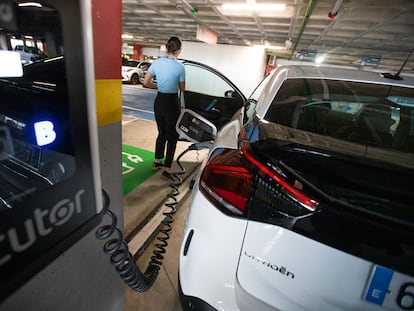Curitiba: Brazil’s sustainable green gem
The South American city’s privileged public transportation network, 48 parks, 13 million square meters of vegetation and a genuine recycling culture ensure that the miracle that began half a century ago will endure


In the 1950s, architect Oscar Niemeyer designed Brasilia as an avant-garde city of the future. Built in only four years (1956-1960), hotels stand side by side, there is a sector with hospitals, another section with embassies, residential areas (which have almost no stores)... all of which are linked by majestic avenues. Drivers do not experience the traffic jams that torment their compatriots, but few cities are as hostile to pedestrians as Brasilia. The distances are so enormous that no one considers walking or even cycling from place to place. Brazil’s capital was planned to cater to the automobile. Despite its unquestionable beauty and uniqueness, the Brasilia model is obsolete.
But Brazil does have a city of the future. It is called Curitiba. Brasilia’s inauguration was still fresh when this city located 1,400 kilometers (about 870 miles) south of the capital implemented an innovative public transportation system — similar to an above-ground subway — with futuristic stops shaped like transparent tubes. These innovations came by virtue of the courage of Curitiba’s mayor, architect and urban planner Jaime Lerner (1937-2021), who was appointed by the military dictatorship. A high-impact, low-cost revolution was beginning.
In a half century, the population has tripled to 1.8 million inhabitants, and public policies have turned Curitiba into a green icon, a sustainable city, a pedestrian-friendly space and the envy of the whole country because its streets are pristine. The city has 48 parks and 13 million square meters of native vegetation. It’s largely unknown abroad outside of environmentalist circles, which have given the city awards, and those who closely followed the legal situation of Brazilian President, Luiz Inácio Lula da Silva, who was previously imprisoned in a Curitiba police station.
Two words summarize the secret formula that made Curitiba a model of sustainability: orderly growth, an anomaly in a country that gave the world the word favela, the shantytown that emerges amid the disorder on the outskirts of cities and welcomes the poor labor force. But the favela struggles in the face of extreme weather events like torrential rains, which kill hundreds of Brazilians in their precarious homes each year.

Located 100 kilometers (62 miles) from the coast and nearly 700 kilometers (about 435 miles) from Iguaçu Falls, Curitiba is the capital of the state of Paraná. This city listened to urban planners in deciding how it wanted to grow and, most strikingly, the politicians complied.
The city was founded at the end of the 17th century. It was born as a gold prospectors’ village and grew thanks to the muleteers who took mules to the mines. Walking through Curitiba now, trees appear everywhere. While the first park dates back to 1886, the rest were created in the last 50 years. The city’s green areas total 60 square meters (about 646 feet) per inhabitant, five times more than the minimum 12 (129 feet) recommended by the World Health Organization (WHO).
The residents of Curitiba are proud of their environmental awareness and seek to make the city’s formula even greener. “The ideas that were sensational in the 1970s have not been improved upon,” laments Grasiela Azevedo, a 41-year-old process analyst. She belongs to the first generation of students who were converted to environmentalism at school, which taught and supervised her parents. “Public transportation during rush hour is so chaotic that I go by bike,” she says during a walk. The cycling network spans 250 kilometers (150 miles), and the plan is to reach 400 (248.5 miles) in two years.
After several years during which mayors stopped prioritizing sustainable growth and environmental issues, an urban planner is once again at the helm of the municipality. Rafael Greca, 67, is a disciple of Lerner, the man who planted the seed for the city’s transformation, and he is embarking on the process of updating that legacy with an ambitious plan for Curitiba to adapt to and mitigate climate change. “Global warming is a trend; it’s not humanity’s destiny. We can change it. We have to convince people and act not only in the rainforest but also in our cities. We are planting 100,000 trees a year here,” the mayor proclaims in his office, where four decades ago the crucial decision was made to establish recycling throughout the municipality.
Environmental education has become so widespread in schools that residents recycle 22% of their garbage. The national average is just three percent. The people of Curitiba separate their waste religiously and boast that they would never throw a piece of paper on the ground. To encourage recycling among the poorest residents, cardboard and other recyclable waste can be recycled in exchange for fruit and vegetables. This collective success story was born with Brazil’s first pedestrian street.
Let’s go back to 1972. Merchants were furious at the mayor’s delusional idea to ban cars on a bustling commercial thoroughfare, XV Street. Lerner was ingenious: the work began on a Friday night so that it could become a reality first thing on Monday morning. When it was time for the stores to open, he had children do drawings in the middle of the road to neutralize any boycotts.
This was not an isolated act, but rather part of a plan meticulously designed by a team of daring young people. By increasing the parks, they reduced the risk of flooding and occupied spaces suitable for shantytowns that would soon become favelas. They expropriated private forests from powerful families and opened them to the public for general enjoyment. The locals jokingly refer to them as Curitiba’s beaches.
The change was created within a public institution under conditions that, at first glance, seem adverse because this is a conservative city and the military still ruled Brazil at the time. But the place where the first Brazilian university was founded in 1912 still felt the global effervescence of the late 1960s.”Curitiba was experiencing an explosion of ideas, the [urban] master plan resulted from a very broad public discussion, the first architects had just graduated and Mayor Lerner had the courage to implement it,” architect and urban planner at Curitiba’s Urban Planning and Research Institute (Ippuc) Rosane Popp explains. This agency has produced three mayors, including the legendary Lerner and the current one, who joined Ippuc at 17 as an intern.
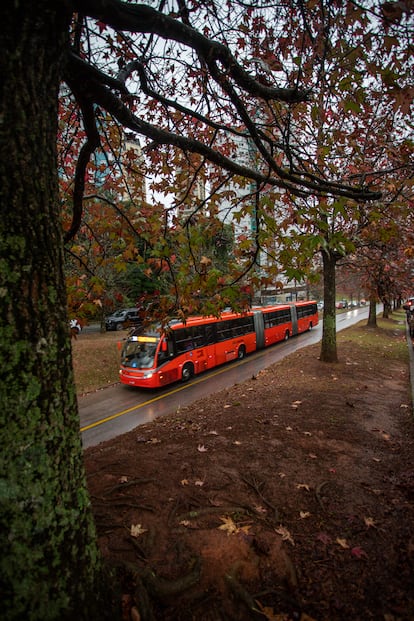

Part of the plan to curb the climate crisis calls for extending the best of the original formula for Curitiba’s neighborhoods. Along with recycling, parks, etc., the main element is a revolutionary public transportation system, which 250 cities around the world — including Bogotá, Istanbul, Marrakesh and Seoul — have been adopting. It is called the Rapid Transit Bus (BRT).
The innovative system involved a radical redesign to decentralize bus lines. North-south and east-west axes, plus a circular network connecting neighborhoods, structure the transport system. Twenty terminals facilitate transfers between lines; it works like an overland subway. For six reais (a little more than a euro or a dollar), one can travel through the entire network.
The city’s great innovation was to create a central and exclusive lane where articulated three-body buses circulate at full speed; the system spans over 80 kilometers (about 50 miles), and on each side, there’s a lane for cars and motorcycles with a speed limit of 30 kilometers (18 miles) per hour so that pedestrians can cross the street without worry.
Suely Hass, the director of planning at Ippuc, where 50 architects are designing the city’s future, emphasizes that the original plan’s guidelines are still being implemented with the relevant updates. They have just allowed more commerce in residential areas to reduce displacements. Following the formula devised by the urban planners, the city gradually grew around these transportation hubs without affecting infrastructure. Skyscrapers are concentrated along the main axes; the farther away buildings are, the fewer floors they have.
Curitiba is a right-wing society that’s wealthier, less unequal and much whiter than the average Brazilian city. It was also at the epicenter of the Lava Jato (Car Wash) investigation — Brazil’s largest corruption case. Most of its residents are descended from immigrant families who arrived from Poland, Italy, Germany, Japan or Ukraine with little more than a dream of prosperity. They were able to carve out a future for themselves with the land provided by the authorities.
Niemeyer left his mark in Curitiba with an eye-shaped museum. The sinuous white building and its French-style botanical garden complete with a greenhouse are postcard-worthy sites. So are the tube-stops, which are easily accessible for baby strollers and people who use a cane or wheelchair. They allow travelers to board quickly through several doors and provide shelter on winter days, when the temperature drops to 10 degrees, and it can rain for 48 hours straight.
Now, the challenge is to make transportation as attractive as it once was and, of course, less polluting at the same time. The BRT transports some 600,000 passengers a day. “If the city continues with current policies, emissions will increase, so we have to go for a disruptive scenario,” architect Popp notes.
Two innovations stand out: improving the connections between neighborhoods and establishing an exclusive lane for the buses that connect them so that private cars cease to compete with them. The goal is for the buses to account for 85% of the trips by 2050 (they currently represent around 50%). Many residents complain about how crowded the buses are, and some would like to have a subway. “What they don’t know is that each kilometer of subway is 1,000 times more expensive than BRT [the current system]; they dream about it because São Paulo has subways,” the mayor explains.
“My authority does not come from imposing policies; the true leader has to create understanding of what needs to be done and thus achieve co-responsibility,” says the politician, who is now in his third term. He cannot run for reelection.
Nalyn Moriah, 26, a musician and director of a suburban children’s choir, embodies one of trailblazing Mayor Lerner’s dreams. In 2018, Lerner said in an interview with EL PAÍS: “Neighborhood life will save the city. School, sports and shopping have to be close by. Culture, theater and museums should be downtown.”
Elsewhere in Brazil, people spend up to four hours a day commuting to and from work (hence the love of social networks), but Moriah has spent most of her life in the same neighborhood. She teaches at the same civic center where she learned to play the guitar as a teenager. She almost always travels by bus or on foot, so she knows where there is room for improvement: “It works better in the center than in the neighborhoods; there could be more buses, the fleet could be more modern, with more frequent schedules,” but nevertheless she loves it here. She has never considered moving out of the city.
Moriah believes that the fight against climate change depends too much on individual behavior and that the solution can only be collective. “Maybe the major problem is plastic; we have to attack it from the production side,” she says.
Curitiba is a service city that also manufactures automobiles, once a key sector in Brazil that gave rise to the middle class. President Lula — who unlike his predecessor promises to protect the Amazon — recently announced incentives for purchasing cars at reasonable prices, a policy intended to boost the industry and ingratiate himself with the middle class. “He is going against the grain of history,” the mayor warns. “I would like the president to offer subsidies that encourage electric urban public transport.”
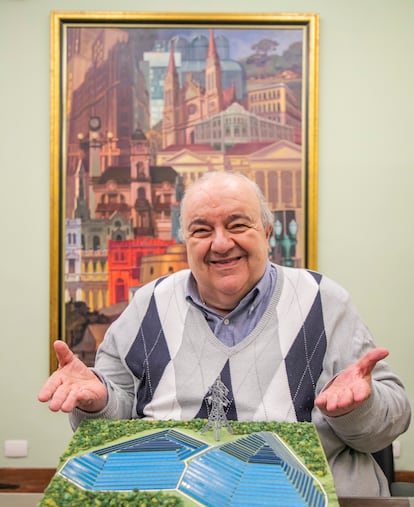
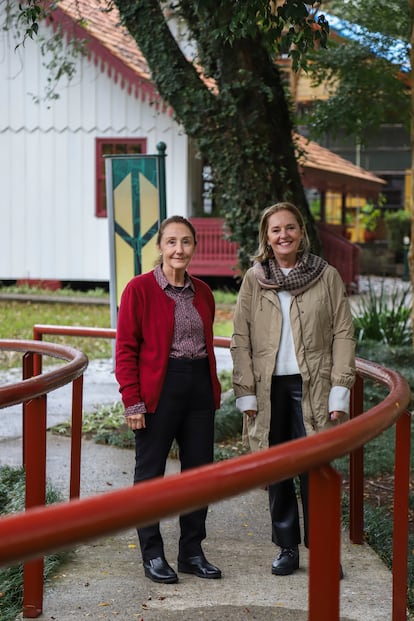
Curitiba’s first 70 electric buses have already been purchased and the erstwhile landfill has been turned into a pyramid covered by thousands of solar panels that generate electricity. Trees are being planted at a furious pace. And the crown jewel is a new sustainable neighborhood that will replace the favela that sprang up a decade ago in an environmental reserve area. The 1,700 families who settled in that floodplain will be relocated next door in housing that they are building themselves. The project costs almost €50 million ($54.55 million), of which the French Development Agency has provided €38 million ($41.46 million).
Back in the 1990s, Curitiba attracted international attention for its good environmental practices, which attracted the Inter-American Development Bank. Other organizations followed, and foreign capital and loans have made many of the projects possible. Mayor Greca highlights the tough fiscal adjustment he enacted to keep the accounts healthy and attract financing when he returned to City Hall in 2016, after his first term in the 1990s.
The streets look exquisite because the residents take care of them, José Francisco Chaerki observes. “If someone throws away a can or a piece of paper, everyone lets him know about it. I’m sure he’s not from Curitiba,” he says proudly. Chaerki drives an uber to supplement the income he earns by washing cars. He takes public transportation to his other job because it takes less time than driving.
Sign up for our weekly newsletter to get more English-language news coverage from EL PAÍS USA Edition
Tu suscripción se está usando en otro dispositivo
¿Quieres añadir otro usuario a tu suscripción?
Si continúas leyendo en este dispositivo, no se podrá leer en el otro.
FlechaTu suscripción se está usando en otro dispositivo y solo puedes acceder a EL PAÍS desde un dispositivo a la vez.
Si quieres compartir tu cuenta, cambia tu suscripción a la modalidad Premium, así podrás añadir otro usuario. Cada uno accederá con su propia cuenta de email, lo que os permitirá personalizar vuestra experiencia en EL PAÍS.
¿Tienes una suscripción de empresa? Accede aquí para contratar más cuentas.
En el caso de no saber quién está usando tu cuenta, te recomendamos cambiar tu contraseña aquí.
Si decides continuar compartiendo tu cuenta, este mensaje se mostrará en tu dispositivo y en el de la otra persona que está usando tu cuenta de forma indefinida, afectando a tu experiencia de lectura. Puedes consultar aquí los términos y condiciones de la suscripción digital.
More information
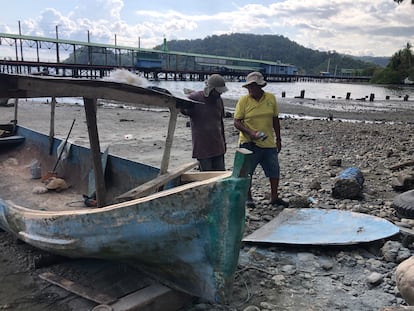
Fishing, sustainability, and cocaine: Is Costa Rica reversing course on its ‘blue agenda’?
Archived In
Últimas noticias
Half of Scotland is in the hands of 420 property owners
Reinhard Genzel, Nobel laureate in physics: ‘One-minute videos will never give you the truth’
Pinochet’s victims grapple with José Antonio Kast’s rise in Chile
From digital curfews to blocking apps: How technology experts protect their children online
Most viewed
- Pablo Escobar’s hippos: A serious environmental problem, 40 years on
- Reinhard Genzel, Nobel laureate in physics: ‘One-minute videos will never give you the truth’
- Why we lost the habit of sleeping in two segments and how that changed our sense of time
- Charles Dubouloz, mountaineering star, retires at 36 with a farewell tour inspired by Walter Bonatti
- The Florida Keys tourist paradise is besieged by immigration agents: ‘We’ve never seen anything like this’
